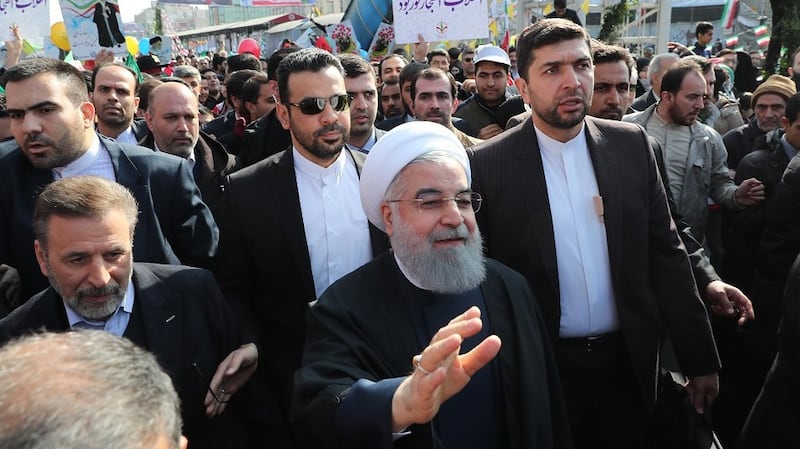Iran’s hardline factions once dubbed him “the miracle of the third millennium”.
But former firebrand president Mahmoud Ahmadinejad has turned into "the ally of the Satan," in the words of one hardliner, as he has become an increasingly disruptive force embarrassing those who secured his path to power.
The populist politician whose presidency was tainted by corruption allegations, suppression and crippling sanctions, has recently heightened his criticism of regime leaders whom he accuses of inefficiency. Some officials believe he may have indirectly stoked the anger against the regime that triggered protests in December that rattled the republic and led to at least 25 deaths.
Mr Ahmadinejad has been largely silent since the unrest erupted. But he resumed his attacks in an open letter to supreme leader Ayatollah Ali Khameneithis week. He spoke of a need for “fundamental reforms” and suggested the head of the judiciary be dismissed. He also called for snap presidential and parliamentary elections, saying they should be held without “interference” from military bodies in order to “restore public trust”.
“His message to the system is that if I am not taken seriously, I will disrupt your game,” said a reformist politician. “His only lever of power is to say ‘I exist’ and to provoke people.”
Mr Ahmadinejad's attacks have mainly targeted hardliners, including Sadegh Larijani and Ali Larijani, who run the judiciary and the parliament respectively. And he has become a thorn in the side of the regime at a particularly sensitive time, with the Islamic republic facing growing social discontent and pressure from the United States over its role in regional conflicts and its ballistic missile programme.
The regime, however, appears to be struggling to contain one of its own.
“The issue of Mr Ahmadinejad is a bit complicated,” said Eshaq Jahangiri, Iran’s first vice-president. “He is not at a level to create a deadlock for the system. But I also wonder why he is not dealt with.”
The judiciary has said it has “files” on Mr Ahmadinejad, which analysts believe could relate to alleged corruption that occurred when he was president from 2005 to 2013.
Fayaz Shojaei, a state prosecutor, said last year that “losses from Ahmadinejad’s decisions are so many that there is no way all of them could be chased”. He added that there were seven cases against the former president for “financial violations”, five related to the oil sector.
Disastrous presidency
Some Iranians believe Mr Ahmadinejad’s attacks are an attempt to deflect from any possible court action against him. The former president has denied any wrongdoing and has said his government was the “cleanest” ever.
“Mr Ahmadinejad’s intention is to save himself from all the allegations against him even if the cost is destroying the supreme leader’s authority,” says one regime insider. “He wants to say that he got into trouble after attacking the supreme leader and raise the stakes of his prosecution over corruption.”
Mr Ahmadinejad took power 13 years ago with the backing of Mr Khamenei and the regime's hardline factions as they sought to counter reformers after Mohammad Khatami, a reformist, had completed two terms. Many Iranians consider Mr Ahmadinejad's presidency to be the most disastrous in the republic's history as the country was plunged into a deep recession and isolated from much of the rest of the world.
Analysts say Mr Khamenei’s support for the populist was arguably the worst political blunder of his reign as supreme leader. Mr Ahmadinejad’s disputed re-election in 2009 sparked the biggest anti-regime protests since the 1979 Islamic revolution.
The demonstrations lasted for months and about 100 died in the unrest. As hundreds of thousands of people took to the streets, Mr Khamenei said “my view is closer to” Mr Ahmadinejad, further infuriating the protesters.
‘Dear people’
The December unrest was the most widespread since the 2009 protests. The regime’s authority has since been challenged by women removing their headscarves in public in contravention of a strict dress codes for women.

In a sign of government concern, President Hassan Rouhani surprised many when he hinted this month that he would be willing to hold referendums on issues that divide reformists and hardliners. Even Mr Khamenei said "we have lagged behind in [establishing] justice . . . We have to apologise to the Almighty God and dear people". But he added that his regime was at no risk. "All should know that the Islamic republic is strong, very strong."
Reform-minded and conservative analysts say Mr Ahmadinejad has little popular support, but add that he can embolden people with his anti-establishment rhetoric.
“It seems Mr Ahmadinejad’s analysis is that the majority of people are against the supreme leader and hence he wants to have a louder voice than reformists,” said another regime insider. “For now, the regime’s policy is to cut off his hands by prosecuting his top allies. But if one day he dares to target the supreme leader directly, he will be put under house arrest immediately.” – Copyright The Financial Times Limited 2018

















